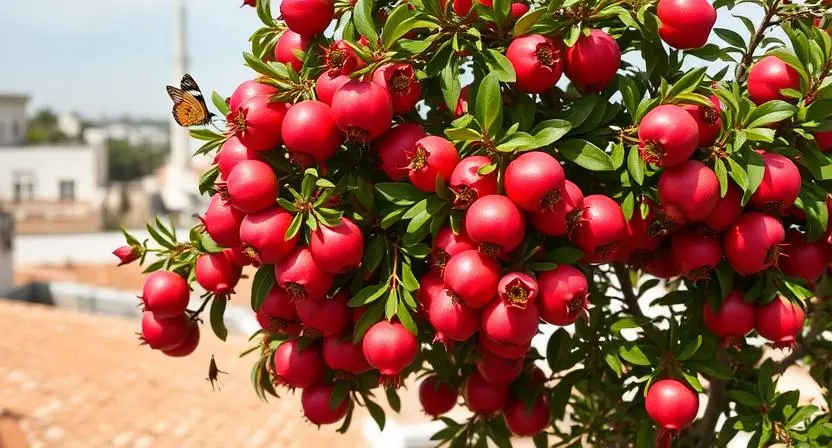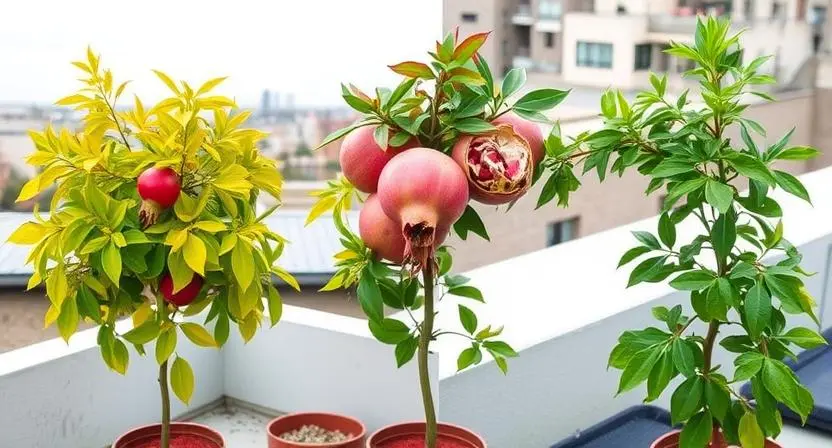How to Grow Pomegranate Tree on Rooftop is a concern that arises among people with small backyards who desire fresh fruit. Pomegranate trees can be successfully cultivated on rooftops, and their abundant flowering and fruiting cycles present a high-value return given their requirement for warm, sunny environments. Proper preparation allows for successful fruit cultivation in limited rooftop areas.
This comprehensive, step-by-step guide details the process of growing a pomegranate tree on a rooftop, from species selection to fruit harvesting.
Why Choose a Pomegranate Tree for Rooftop Gardening?
Pomegranate trees are some of the best rooftop crops due to the fact that they are drought-resistant, flexible, and also easy to control in pots. Pomegranate trees, unlike big fruit trees that will need long and deep roots, can grow in a relatively small area, such as in pots on the rooftop.
And they are ornamental as well as edible fruit-givers. The red flowers of the plant are very beautiful, and the fruits contain a lot of antioxidants, minerals, and vitamins. This combination of features positions the pomegranate as an excellent choice for urban gardening, maximizing both ornamental and edible value in rooftop settings.
Best Varieties of Pomegranate for Rooftop Gardening
Not every variety of pomegranate is meant to grow on the rooftop or in a container. Dwarf and semi-dwarf varieties are the most appropriate since they are compact without compromising the quality of the fruits.
Recommended Rooftop Varieties:
- Nana (Dwarf Pomegranate): It is compact, reaches not more than 3-4 feet in height, and cultivates well in a pot.
- Bhagwa: Popular in South Asia, this variety is noted for producing large, sweet fruits.
- Wonderful: This is a usual variety to cultivate, which has a medium-sized tree that is also easily cultivated in large pots.
- Ganesh: It is an Indian type with soft seeds that bear a good quantity of fruit.
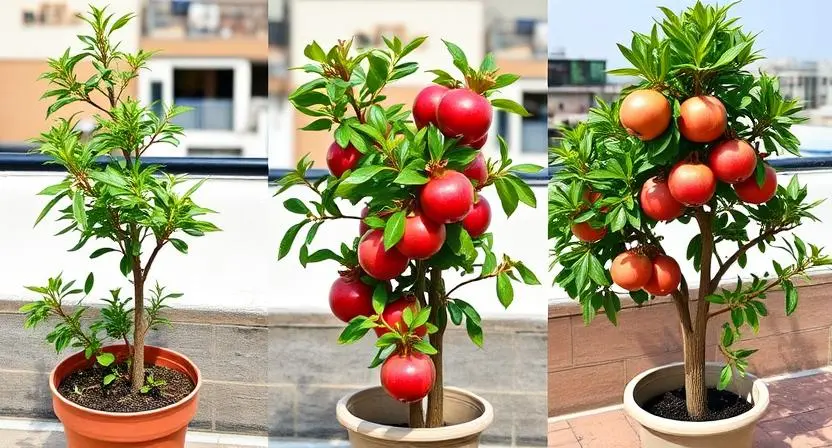
Key Requirements for Cultivating Pomegranate on a Rooftop
Successful pomegranate cultivation necessitates addressing the following environmental and physical requirements.
1. Sunlight
Pomegranates require a full sun environment of at least 6-8 hours daily. The container must be positioned in a location that maximizes direct sunlight exposure.
2. Container Size
Use a container that is at least 20-24 inches deep and wide so that roots can grow properly.
3. Soil Mix
A good soil mix that drains well is important because pomegranate trees do not like having their roots stay in wet soil.
Ideal Rooftop Soil Mix Table (Short & Concise):
| Material | Ratio |
| Garden Soil | 40% |
| Compost | 30% |
| Sand/Perlite | 30% |
4. Watering Needs
Water regularly, but do not overwater. Allow the soil to dry slightly in between waterings.
5. Fertilization
In the growing season, add a balanced organic fertilizer to the tree.
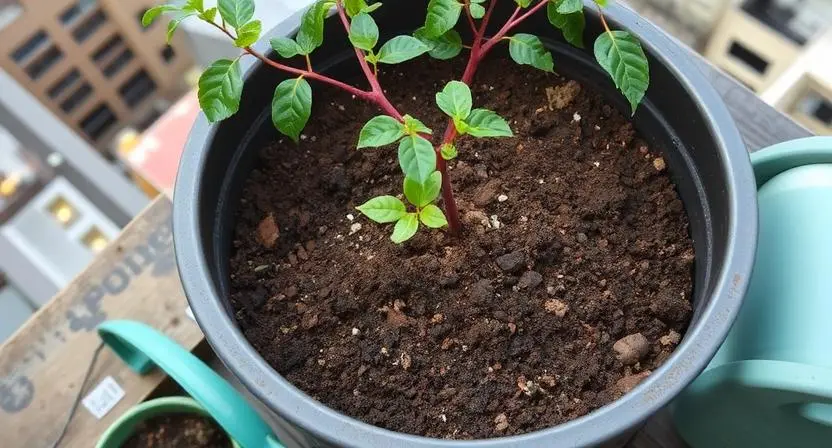
External Reference
Reference & Expert Note:
According to the Food and Agriculture Organization (FAO) and multiple urban horticulture research projects, rooftop pomegranate gardening has proven to be a sustainable fruit cultivation method in warm climates.
Proper container size, well-drained soil, and adequate sun exposure are the key factors behind successful rooftop harvests.
(Source: FAO Urban Agriculture Guidelines)
Step-by-Step Guide: How to Grow Pomegranate Tree on Rooftop
The following steps detail the process for establishing a rooftop pomegranate garden:
Step 1: Selecting the Right Pot
Select a strong container of clay, plastic, or cement. Make sure it has drainage holes below so as to avoid root rot.
Step 2: Preparing the Soil
Mix the garden soil, compost, and sand/perlite in the given ratio. This gives aeration and reasonable feeding.
Step 3: Planting the Pomegranate
- Buy a sapling in good health at the nursery.
- Put small stones on the bottom part of the container that will help with drainage.
- Fill the soil mix pot to the top, leaving some space.
- Put the sapling in the middle and place the soil around the root.
Step 4: Initial Watering
Post-planting, water thoroughly. Maintain damp but not saturated soil conditions.
Step 5: Positioning on Rooftop
The container should be located in a position receiving high sunlight intensity, while minimizing exposure to strong winds.
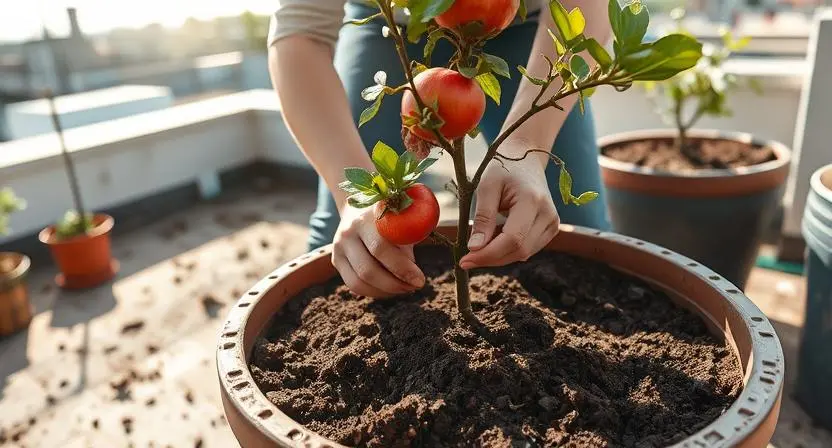
Caring for Your Rooftop Pomegranate Tree
Successful cultivation requires knowledge of both planting and consistent, routine care.
Watering Schedule
Deep watering should be applied sparingly to the pomegranate tree. During the summer, watering frequency should be increased to 2-3 times per week. Nevertheless, watering should be less frequent in winter; once per week will be enough.
Fertilizing Routine
Add to the organic compost every 23 months. Apply potash-rich fertilizer during the fruiting stage in order to increase sweetness.
Pruning and Training
Pruning maintains the plant compact and invites more fruit-bearing branches. When dead or crossing branches are to be removed, do it in late winter
Pest and Disease Management
- Aphids: Spray a neem oil solution.
- Fruit Borer: Coat the fruits with an organic pesticide or place paper bags over the fruits.
- Leaf Spot: Remove the infected leaves and make sure there is proper air flow.
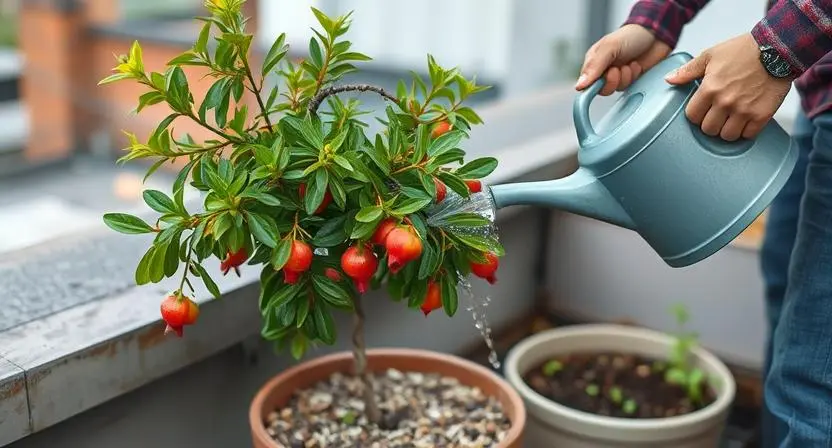
Flowering and Fruiting of Rooftop Pomegranate Trees
Pomegranate trees tend to flower in their first or second year when they are planted as a sapling. Sepals are red in color, a trait that facilitates the attraction of pollinators.
- Flowering Time: The time of the flowering is spring and early summer.
- Fruiting Period: The fruits require between five to six months before they fully mature once the flowers have flowered.
Quick Fruiting Timeline Table:
| Stage | Time Taken |
| Flowering | 1–2 years |
| Fruit Set | 5–6 months |
Common Problems in Rooftop Pomegranate Gardening
Even if you know how to grow pomegranate tree on rooftop, challenges may arise. Here are common issues:
- Yellowing Leaves: This normally occurs through over-watering or deprivation of nutrients
- Fruit Cracking: This is due to uneven watering.
- Poor Flowering: The prevalence of a lack of sunlight or wrong pruning.
- Small fruits: Stress due to lack of fertilizer or water stress
Simple Problem-Solution Table:
| Problem | Quick Fix |
| Yellow Leaves | Reduce watering |
| Fruit Cracking | Regular watering |
| Small Fruits | Add fertilizer |
Harvesting Pomegranates from Rooftop
Determining the optimal harvest time is a critical aspect of effective pomegranate cultivation.
- Signs of Ripeness:
- Fruit skin turns deep red.
- The fruit feels heavy.
- Tapping produces a metallic sound.
- Fruit skin turns deep red.
Cut ripening fruits with care using scissors or pruning shears so as not to injure the branches.
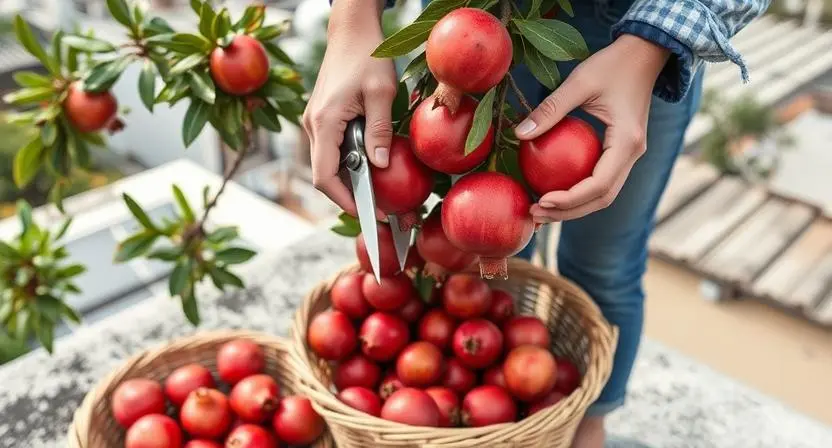
Benefits of Growing Pomegranate Tree on Rooftop
Here are some of the benefits of rooftop pomegranate gardening:
- Produce is pesticide-free, ensuring the retention of natural flavors and nutritional integrity.
- Space Saving: Ideal allocation of space in urban dwellings with no backyard.
- Improved Air Quality: Adds much rooftop greenery.
- Cuts cost used in purchasing the costly pomegranates.
- Contributes to sustainable practices by reducing reliance on commercial distribution and packaging.
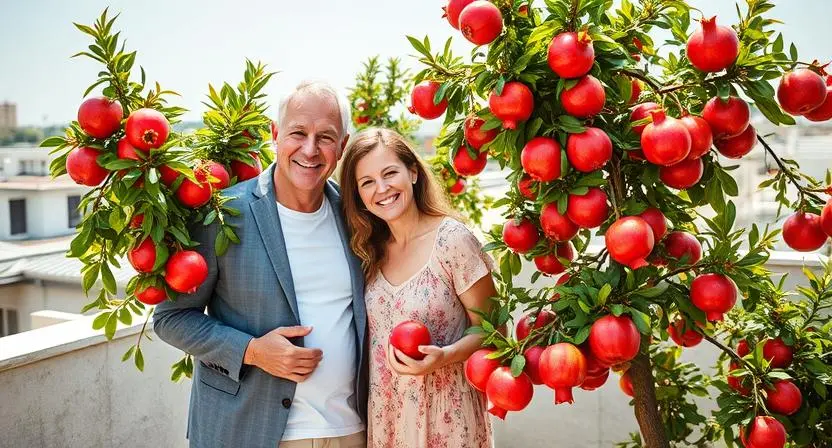
Real-Life Success Story
In Texas, a small rooftop gardener named Jenifer Alex planted two dwarf pomegranate trees in 22-inch pots.
Within one year, her trees produced over 30 fruits, and the red flowers attracted pollinators naturally.
By using only compost and regular pruning, she created a sustainable rooftop mini-orchard, proving that even in limited spaces, pomegranate trees can thrive beautifully.
Tips for Maximum Yield from Rooftop Pomegranate Trees
- Apply a large container to provide enhanced root spread.
- Use mulch to prevent soil moisture.
- Pollinate flowers manually in case pollinators are few.
- Prune the tree to form a bushy appearance in order to have more fruits.
- Incorporate one inch of compost each year.
Expert Insight
This cultivation guide is based on practical rooftop gardening practices commonly used in South Asia and supported by horticultural experts.
Pomegranate is a resilient fruit tree suitable for urban gardening, and its success depends on proper sunlight, soil mix, and pruning techniques.
These steps reflect real-world results from rooftop gardeners who follow eco-friendly, organic methods.
Author Expertise & Source Credibility
This rooftop pomegranate gardening guide is developed by referencing trusted agricultural and horticultural sources.
- Author Expertise: This guide is compiled based on practical urban gardening techniques used in South Asia and rooftop gardening trends practiced worldwide.
- Primary Sources:
- Food and Agriculture Organization (FAO) Urban Agriculture Guidelines
- Real-world case studies from small rooftop gardeners
- Expert recommendations from horticulture professionals
- Transparency: The techniques mentioned here are eco-friendly, organic, and beginner-friendly, ensuring accurate and practical application for urban growers.
- Purpose: To provide verified, helpful, and actionable steps so that any urban gardener can successfully grow pomegranate trees on their rooftop.
Conclusion
Pomegranate cultivation on a rooftop is a viable, high-yield application of urban container gardening. Adherence to the specified requirements for sun exposure, appropriate container size, soil composition, and consistent pruning allows for the successful production of fruit in limited spaces. Implementing these steps enables growers to utilize rooftops for creating productive, sustainable, and long-term sources of fresh fruit.


